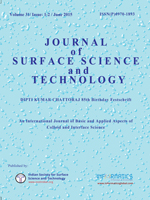Preparation and Characterization of Activated Carbon from Residues of Oregano
Subscribe/Renew Journal
The objective of this study is to value the residues of oregano by an evaluation of the performances of the activated carbon elaborated from this precursor based on the phenomenon of adsorption described in the bibliographical studies. After the process of chemical activation of oregano marc by the phosphoric acid 80 % (1/1) at 350°C during 60 min, the specificity of obtained material is defined from two parameters. The first one is related to the existence of surface chemical functional groups, the second parameter concerns the porous texture defined by the specific surface area according to the Brunauer, Emmet and Teller method (B.E.T), the microporous surface according to the thickness method, the pore size distribution and the structural morphology of the material. The adsorption study of the activated carbon from residues of oregano hence provides evidence for better activity and surface area than commercial activated carbons and could be tried in water treatment process.
Keywords
Activated Carbon, BET Surface Area, Micropore Area, Surface Chemical Functional Groups.
Subscription
Login to verify subscription
User
Font Size
Information

Abstract Views: 290

PDF Views: 2



